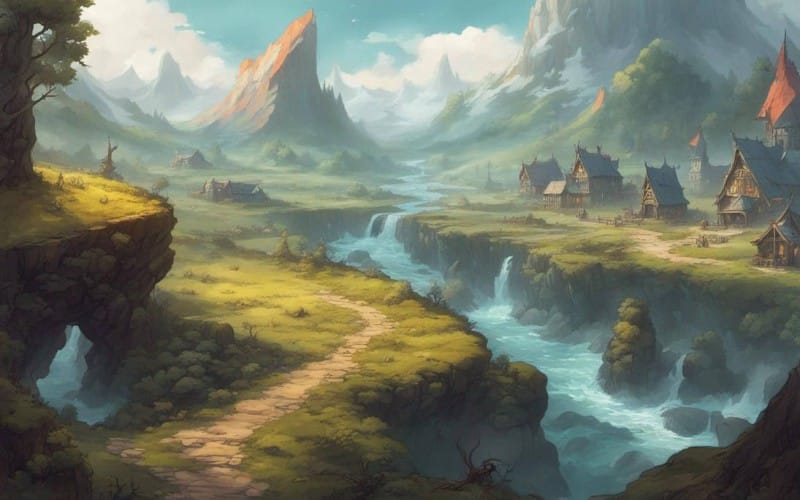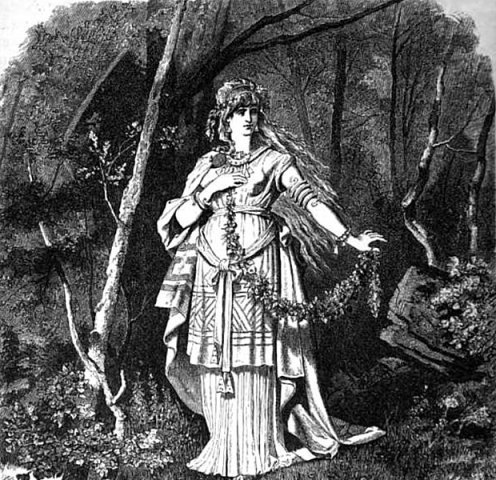In the lore of Norse mythology, popular belief has it that Freyja chooses half the slain warriors on the battlefield. She even gets to choose first among them, then whisk them away to her great hall Sessrumnir, located in Folkvangr. This story has always confounded me, as I don’t understand Odin’s motivation to give up all these great warriors.
In this post I will dive into what we really know about Folkvangr, and discuss what makes more sense. One thing which is for sure a pervasive misunderstanding is that Folkvangr is Freyja’s hall. It isn’t, it is the meadow, or great field, where her hall Sessrumnir is located. There are several established facts in Norse mythology with little or no real evidence. The common understanding of Folkvangr might be one such myth.
Etymology and Meaning of Fólkvangr

In Old Norse, the name is Fólkvangr which can be interpreted in two different ways. To begin with the end, the –vangr part means meadow or field. Just as Odins’ hall Valhalla is located in the field/meadow Gladsheim, and Vidar’s land is called Vithi, Freyja has a meadow/field.
However, the Fólk beginning is slightly more challenging. In the Elder Edda poems, it means army, or some large group of warriors. In more modern Old Norse though, it has come to mean people, like kinfolk means folk who are your kin.
I think that in this context, it is the army/group of warriors translation that is most appropriate. As such, then the name of Freyja’s land is close to meaning the “Warrior’s field”, more than anything else.
Origins and Location
As soon as you start trying to explain the background of Folkvangr and where it’s located things get tricky fast. Thing is, not much is really known of Freyja’s land, not even where it was. The only reference to it of any value is in one poem called Grímnismál, from the Poetic Edda. The slightly later mention of it in Snorri’s Gylfaginning is really just a quote from this poem so adds little substance.
In the Grímnismál, Odin shares information about many mythological places, like the halls and fields/lands of many of the gods. However, in it Odin mentions places that are both in Asgard and Jotunheim, and possibly in Midgard. Based on this there is no way to tell if Folkvangr is in Asgard, or indeed somewhere else, like Vanaheim.
With little or no real facts, or hard evidence, we can only speculate about where it is located. For me, there is only one likely location, and that is in Asgard. This is based on the fact that Njörd, and his two children Freyja and Freyr, came to live with the Aesir after the war with the Vanir. This alone basically disqualifies any other location for it to exist. I emphasize this as the location kind of plays into some other possible confusion with regards to Folkvangr and its place in the Norse myths.
Folkvangr’s Role in Norse Mythology
There is a common popular belief that Freyja chooses among the warriors who fall in battle, and takes half of them. They do not go to Valhalla. Instead they go with Freyja to Folkvangr, and her hall there which is called Sessrumnir.
This is also based on the Grímnislmál poem, verse fourteen, see English translation below.
- The ninth is Folkvangr, | there Freyja rules
Over who shall have a seat in the hall;
Half of the slain, she choose each day,
The other half is Odin’s.
It is this reference, and only this, that is the basis for the belief that Freyja receives half of the slain, and they live in her hall Sessrumnir. Odin’s hall Valhalla on the other hand is mentioned numerous times in both Poetic Edda poems, the Prose Edda and different sagas. The same are the Einherjar, Odin’s chosen warriors whom he hopes against all odds might secure a victory at Ragnarök.
Warriors Going to Folkvangr Makes No Sense
Why on earth would Odin, the All-Father, ruler of Asgard and the gods, supposedly agree to something like this? Odin has devoted his whole existence in the pursuit of knowledge, and warriors. A pursuit that is so important that the end goal always justifies whatever means he might employ. He is desperately looking for a way to save both the gods and mankind, no less. Yet, despite all that, Freyja just gets to pick and choose all the best warriors, and keep them for some obscure reason in her hall?
This seems to me so meaningless and in contradiction to everything else that is known that it makes little or no sense. In fact, I do not think it is right. I do not think Freyja amassed a great army of the best dead warriors and just had them hang out in her hall Sessrumnir for no good reason.
Alternative Explanations
As I see it, there are really only two reasonable alternatives that can explain the mystery of all the warriors going to Folkvangr. The first and simplest explanation is that no fallen warriors went there. The whole idea about Folkvangr being a possible destination in the afterlife is a misunderstanding on behalf of the person who at one time wrote down the Grímnismál poem.
This might in part be based on Freyja actually being the leader of the Valkyries. If she is, it would be only natural she would choose first, then the other Valkyries picked among the rest. In this alternative then, Freyja chooses half of the slain, but they join the ranks of Odin’s Einherjar in Valhalla.
The second alternative I can think of is that Freyja indeed chose among the fallen first. The ones she chose then came to live with the army she built in Folkvangr. The biggest problem with this, and there are a few, is the complete lack of any mention of a second “warriors heaven” in Asgard, in any of the ancient texts. The second obvious problem here is why she needed the army in the first place.
Was Folkvangr in Vanaheim?
One, semi-plausible theory I have is that Folkvangr is located in Vanaheim, not Asgard, and that the warriors Freyja receives are going to protect it in Ragnarök. Again, there is no mention of this anywhere, and little or no real mention of Vanaheim either so no way to explore this. However, we know that Vanaheim actually survives Ragnarök and at least Njörd goes back there after most of the gods are killed. Maybe it survives because of Freyjas’ warriors…. but again we have no facts to lean on.
Last Thoughts
The enigma that is Folkvangr, and its role in Norse mythology is quite interesting. Sadly we will likely never discover what the old Norsemen actually believed. In trying to eradicate all things pagan, the Church, and Christians were eager to burn all old books and manuscripts of paganism after the Christianization of Scandinavia. Possibly, more books, and knowledge, went up in flames in Medieval times than we have left today.
Featured Image Credit: frostwalkers on Deviantart


I recommend Jackson Crawford’s video on these subjects (Folkvangr, Freyja-Frigg and Valhöll). He simply states that Folkvangr is the field where Valhöll is, otherwise the same place, and that the last line in that stanza is always wrongly translated. There is no “other half” in the text, and the way he translates it, admitting it’s a hard sentence (and of a certain phrasing alien to English), it says “she chooses half of the fallen, and Odin owns half”. I. e., implying Odin simply owns them. What better suited job for her, the Queen of Valkyries, than to choose (judging) her husband’s guests, being after all the mistress of their house/hall (like any wife would do). It doesn’t make much sense to duplicate an afterlife, with them being so similar in character and guests.
Hey, yeah I agree, would make no sense to have half go to some holiday home with Freyja, not fighting the good fight. Thanks for voicing your thoughts!
Marius